International HRM Report: Concepts, Theories, and Critique
VerifiedAdded on 2023/01/18
|19
|5355
|49
Report
AI Summary
This report delves into the core concepts and theories of International Human Resource Management (IHRM), highlighting its crucial role in multinational organizations. It begins by defining IHRM and contrasting it with domestic HRM, emphasizing the complexities introduced by international operations, including staffing, training, and cultural diversity. The report then critically compares key IHRM concepts, such as expatriate management, the influence of cultural differences (using Hofstede's model), and the convergence versus divergence of HRM practices across countries. Furthermore, the report critiques the application of HRM functions in an international context, addressing challenges related to risk management, workforce diversity, compensation, and strategic alliances. The analysis underscores the strategic importance of IHRM in achieving organizational goals and navigating the complexities of the global market.
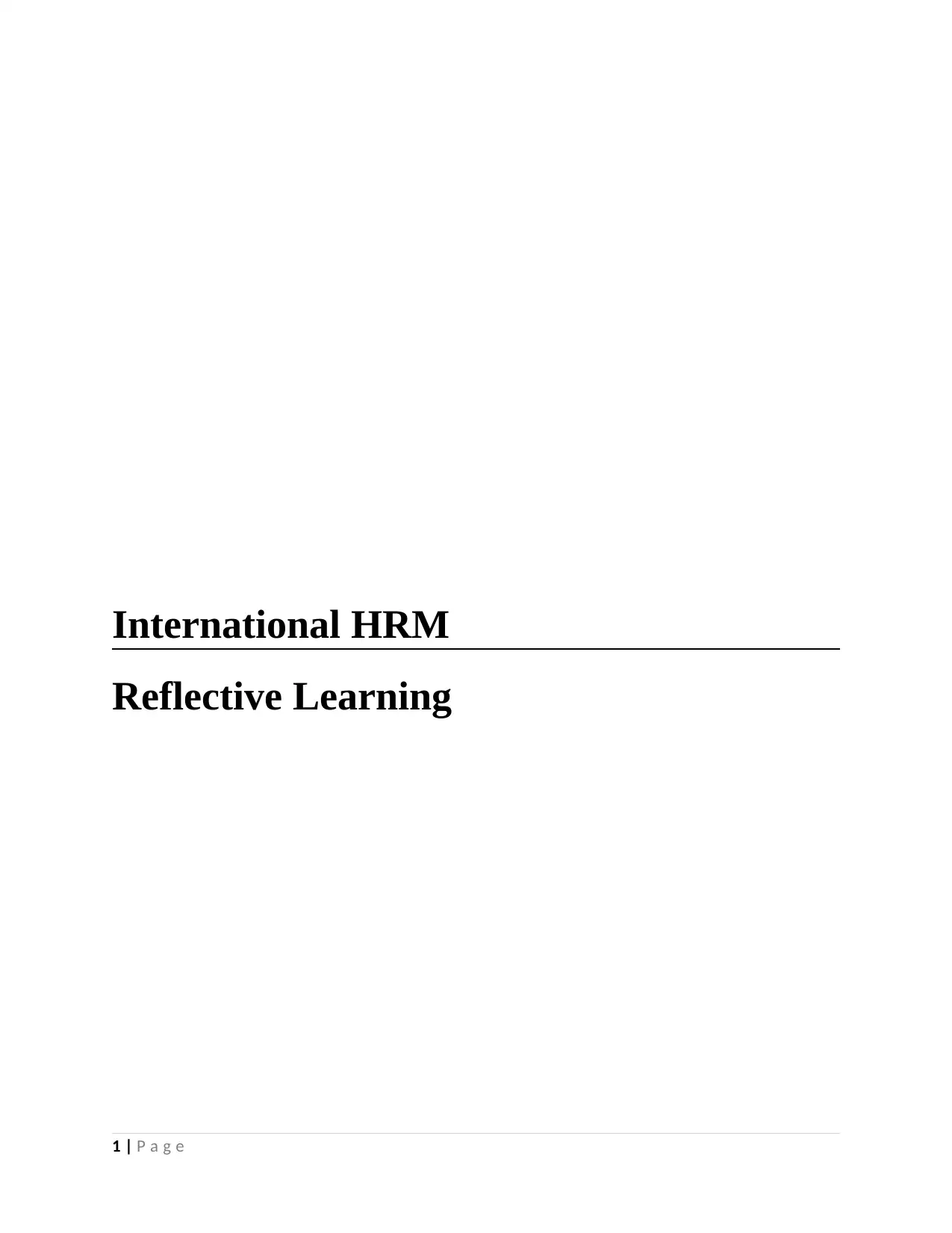
International HRM
Reflective Learning
1 | P a g e
Reflective Learning
1 | P a g e
Paraphrase This Document
Need a fresh take? Get an instant paraphrase of this document with our AI Paraphraser
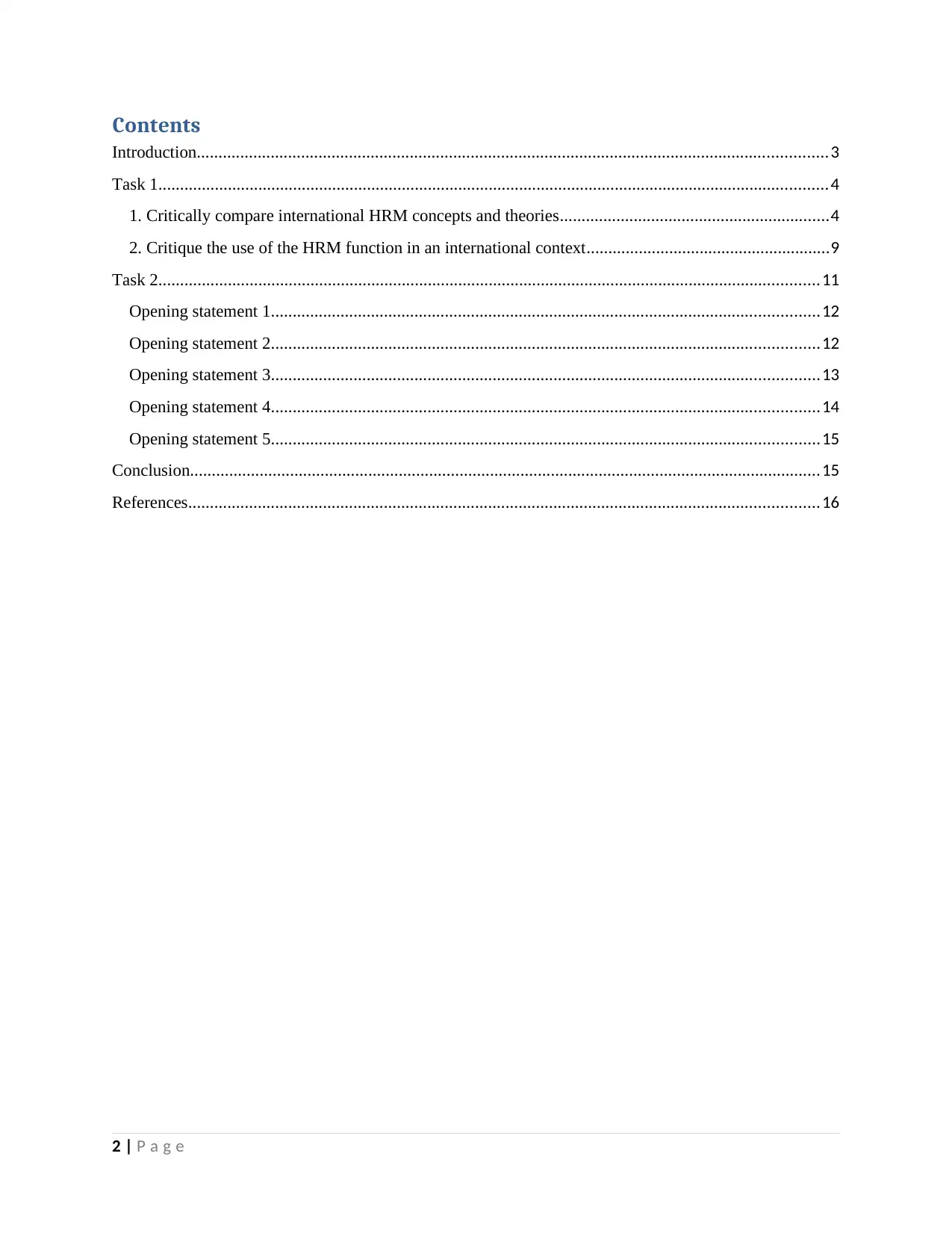
Contents
Introduction.................................................................................................................................................3
Task 1..........................................................................................................................................................4
1. Critically compare international HRM concepts and theories..............................................................4
2. Critique the use of the HRM function in an international context........................................................9
Task 2........................................................................................................................................................11
Opening statement 1..............................................................................................................................12
Opening statement 2..............................................................................................................................12
Opening statement 3..............................................................................................................................13
Opening statement 4..............................................................................................................................14
Opening statement 5..............................................................................................................................15
Conclusion.................................................................................................................................................15
References.................................................................................................................................................16
2 | P a g e
Introduction.................................................................................................................................................3
Task 1..........................................................................................................................................................4
1. Critically compare international HRM concepts and theories..............................................................4
2. Critique the use of the HRM function in an international context........................................................9
Task 2........................................................................................................................................................11
Opening statement 1..............................................................................................................................12
Opening statement 2..............................................................................................................................12
Opening statement 3..............................................................................................................................13
Opening statement 4..............................................................................................................................14
Opening statement 5..............................................................................................................................15
Conclusion.................................................................................................................................................15
References.................................................................................................................................................16
2 | P a g e
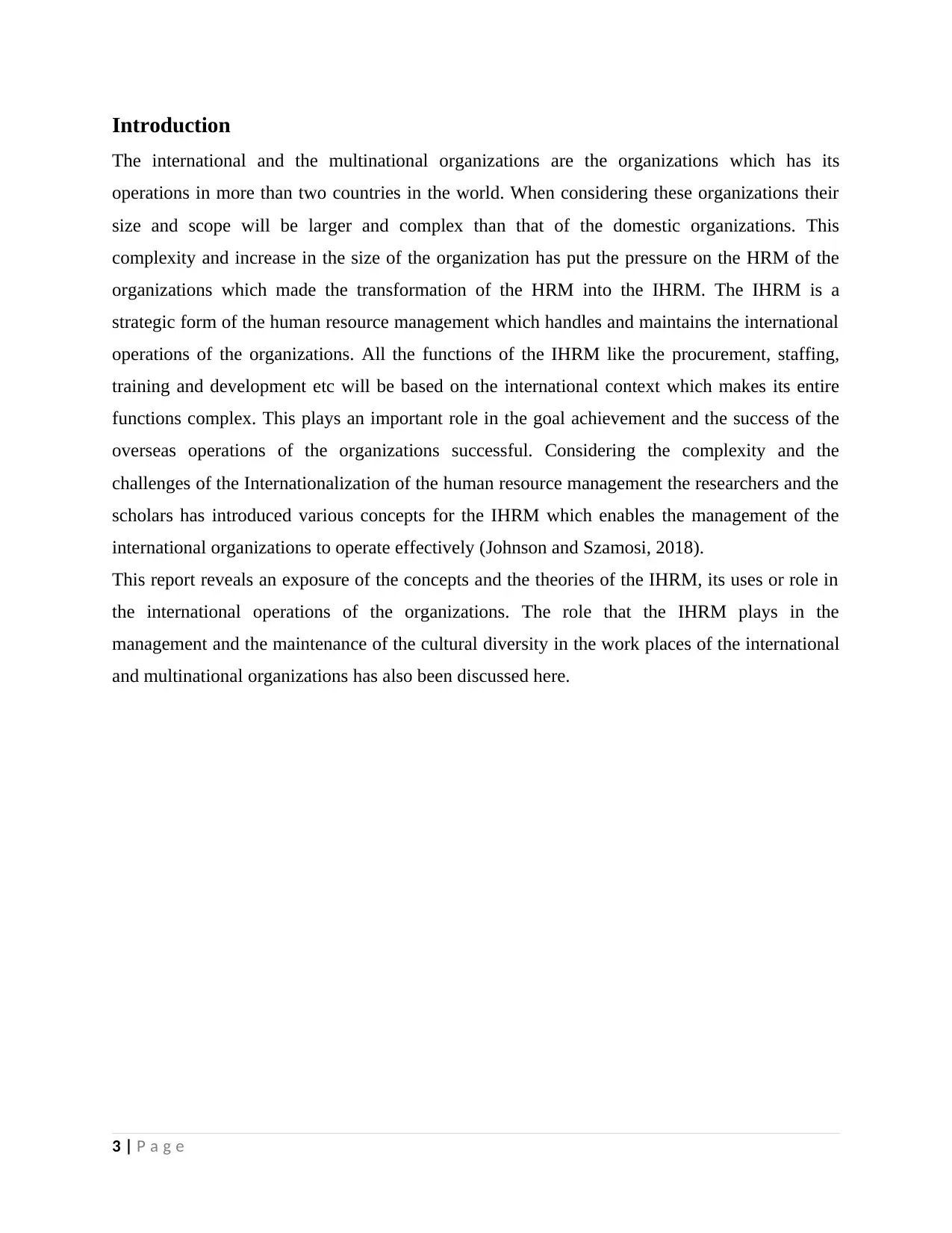
Introduction
The international and the multinational organizations are the organizations which has its
operations in more than two countries in the world. When considering these organizations their
size and scope will be larger and complex than that of the domestic organizations. This
complexity and increase in the size of the organization has put the pressure on the HRM of the
organizations which made the transformation of the HRM into the IHRM. The IHRM is a
strategic form of the human resource management which handles and maintains the international
operations of the organizations. All the functions of the IHRM like the procurement, staffing,
training and development etc will be based on the international context which makes its entire
functions complex. This plays an important role in the goal achievement and the success of the
overseas operations of the organizations successful. Considering the complexity and the
challenges of the Internationalization of the human resource management the researchers and the
scholars has introduced various concepts for the IHRM which enables the management of the
international organizations to operate effectively (Johnson and Szamosi, 2018).
This report reveals an exposure of the concepts and the theories of the IHRM, its uses or role in
the international operations of the organizations. The role that the IHRM plays in the
management and the maintenance of the cultural diversity in the work places of the international
and multinational organizations has also been discussed here.
3 | P a g e
The international and the multinational organizations are the organizations which has its
operations in more than two countries in the world. When considering these organizations their
size and scope will be larger and complex than that of the domestic organizations. This
complexity and increase in the size of the organization has put the pressure on the HRM of the
organizations which made the transformation of the HRM into the IHRM. The IHRM is a
strategic form of the human resource management which handles and maintains the international
operations of the organizations. All the functions of the IHRM like the procurement, staffing,
training and development etc will be based on the international context which makes its entire
functions complex. This plays an important role in the goal achievement and the success of the
overseas operations of the organizations successful. Considering the complexity and the
challenges of the Internationalization of the human resource management the researchers and the
scholars has introduced various concepts for the IHRM which enables the management of the
international organizations to operate effectively (Johnson and Szamosi, 2018).
This report reveals an exposure of the concepts and the theories of the IHRM, its uses or role in
the international operations of the organizations. The role that the IHRM plays in the
management and the maintenance of the cultural diversity in the work places of the international
and multinational organizations has also been discussed here.
3 | P a g e
⊘ This is a preview!⊘
Do you want full access?
Subscribe today to unlock all pages.

Trusted by 1+ million students worldwide
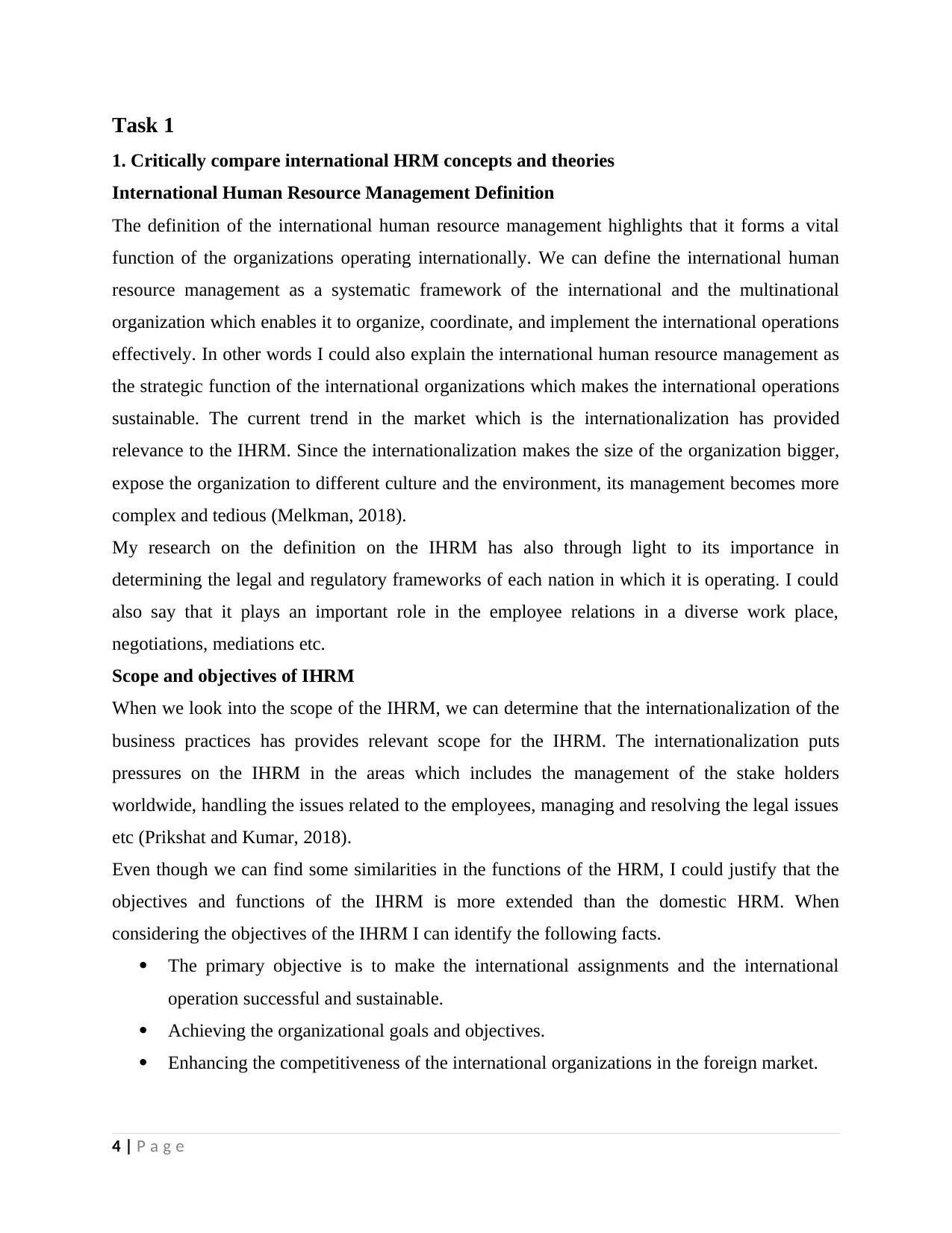
Task 1
1. Critically compare international HRM concepts and theories
International Human Resource Management Definition
The definition of the international human resource management highlights that it forms a vital
function of the organizations operating internationally. We can define the international human
resource management as a systematic framework of the international and the multinational
organization which enables it to organize, coordinate, and implement the international operations
effectively. In other words I could also explain the international human resource management as
the strategic function of the international organizations which makes the international operations
sustainable. The current trend in the market which is the internationalization has provided
relevance to the IHRM. Since the internationalization makes the size of the organization bigger,
expose the organization to different culture and the environment, its management becomes more
complex and tedious (Melkman, 2018).
My research on the definition on the IHRM has also through light to its importance in
determining the legal and regulatory frameworks of each nation in which it is operating. I could
also say that it plays an important role in the employee relations in a diverse work place,
negotiations, mediations etc.
Scope and objectives of IHRM
When we look into the scope of the IHRM, we can determine that the internationalization of the
business practices has provides relevant scope for the IHRM. The internationalization puts
pressures on the IHRM in the areas which includes the management of the stake holders
worldwide, handling the issues related to the employees, managing and resolving the legal issues
etc (Prikshat and Kumar, 2018).
Even though we can find some similarities in the functions of the HRM, I could justify that the
objectives and functions of the IHRM is more extended than the domestic HRM. When
considering the objectives of the IHRM I can identify the following facts.
The primary objective is to make the international assignments and the international
operation successful and sustainable.
Achieving the organizational goals and objectives.
Enhancing the competitiveness of the international organizations in the foreign market.
4 | P a g e
1. Critically compare international HRM concepts and theories
International Human Resource Management Definition
The definition of the international human resource management highlights that it forms a vital
function of the organizations operating internationally. We can define the international human
resource management as a systematic framework of the international and the multinational
organization which enables it to organize, coordinate, and implement the international operations
effectively. In other words I could also explain the international human resource management as
the strategic function of the international organizations which makes the international operations
sustainable. The current trend in the market which is the internationalization has provided
relevance to the IHRM. Since the internationalization makes the size of the organization bigger,
expose the organization to different culture and the environment, its management becomes more
complex and tedious (Melkman, 2018).
My research on the definition on the IHRM has also through light to its importance in
determining the legal and regulatory frameworks of each nation in which it is operating. I could
also say that it plays an important role in the employee relations in a diverse work place,
negotiations, mediations etc.
Scope and objectives of IHRM
When we look into the scope of the IHRM, we can determine that the internationalization of the
business practices has provides relevant scope for the IHRM. The internationalization puts
pressures on the IHRM in the areas which includes the management of the stake holders
worldwide, handling the issues related to the employees, managing and resolving the legal issues
etc (Prikshat and Kumar, 2018).
Even though we can find some similarities in the functions of the HRM, I could justify that the
objectives and functions of the IHRM is more extended than the domestic HRM. When
considering the objectives of the IHRM I can identify the following facts.
The primary objective is to make the international assignments and the international
operation successful and sustainable.
Achieving the organizational goals and objectives.
Enhancing the competitiveness of the international organizations in the foreign market.
4 | P a g e
Paraphrase This Document
Need a fresh take? Get an instant paraphrase of this document with our AI Paraphraser
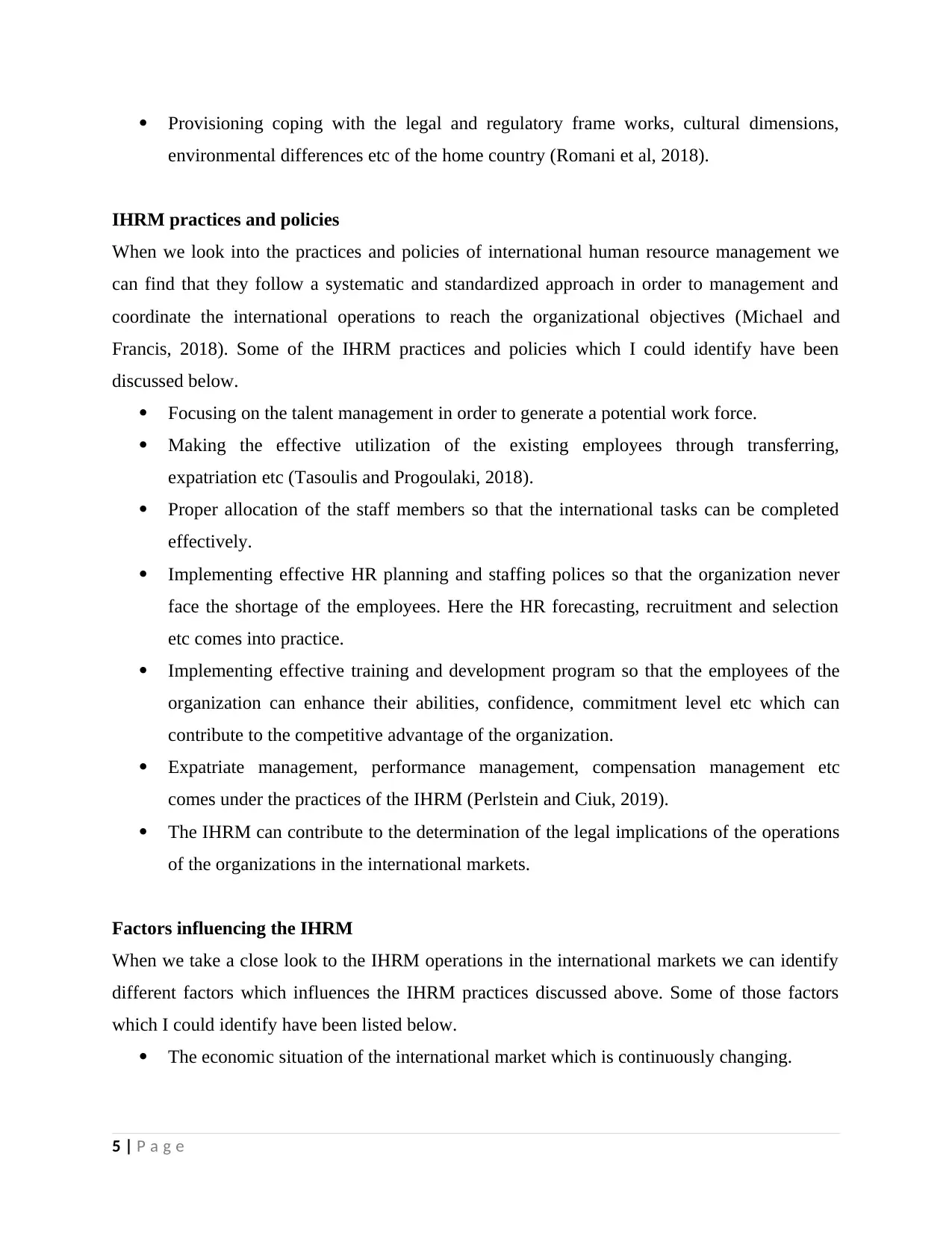
Provisioning coping with the legal and regulatory frame works, cultural dimensions,
environmental differences etc of the home country (Romani et al, 2018).
IHRM practices and policies
When we look into the practices and policies of international human resource management we
can find that they follow a systematic and standardized approach in order to management and
coordinate the international operations to reach the organizational objectives (Michael and
Francis, 2018). Some of the IHRM practices and policies which I could identify have been
discussed below.
Focusing on the talent management in order to generate a potential work force.
Making the effective utilization of the existing employees through transferring,
expatriation etc (Tasoulis and Progoulaki, 2018).
Proper allocation of the staff members so that the international tasks can be completed
effectively.
Implementing effective HR planning and staffing polices so that the organization never
face the shortage of the employees. Here the HR forecasting, recruitment and selection
etc comes into practice.
Implementing effective training and development program so that the employees of the
organization can enhance their abilities, confidence, commitment level etc which can
contribute to the competitive advantage of the organization.
Expatriate management, performance management, compensation management etc
comes under the practices of the IHRM (Perlstein and Ciuk, 2019).
The IHRM can contribute to the determination of the legal implications of the operations
of the organizations in the international markets.
Factors influencing the IHRM
When we take a close look to the IHRM operations in the international markets we can identify
different factors which influences the IHRM practices discussed above. Some of those factors
which I could identify have been listed below.
The economic situation of the international market which is continuously changing.
5 | P a g e
environmental differences etc of the home country (Romani et al, 2018).
IHRM practices and policies
When we look into the practices and policies of international human resource management we
can find that they follow a systematic and standardized approach in order to management and
coordinate the international operations to reach the organizational objectives (Michael and
Francis, 2018). Some of the IHRM practices and policies which I could identify have been
discussed below.
Focusing on the talent management in order to generate a potential work force.
Making the effective utilization of the existing employees through transferring,
expatriation etc (Tasoulis and Progoulaki, 2018).
Proper allocation of the staff members so that the international tasks can be completed
effectively.
Implementing effective HR planning and staffing polices so that the organization never
face the shortage of the employees. Here the HR forecasting, recruitment and selection
etc comes into practice.
Implementing effective training and development program so that the employees of the
organization can enhance their abilities, confidence, commitment level etc which can
contribute to the competitive advantage of the organization.
Expatriate management, performance management, compensation management etc
comes under the practices of the IHRM (Perlstein and Ciuk, 2019).
The IHRM can contribute to the determination of the legal implications of the operations
of the organizations in the international markets.
Factors influencing the IHRM
When we take a close look to the IHRM operations in the international markets we can identify
different factors which influences the IHRM practices discussed above. Some of those factors
which I could identify have been listed below.
The economic situation of the international market which is continuously changing.
5 | P a g e
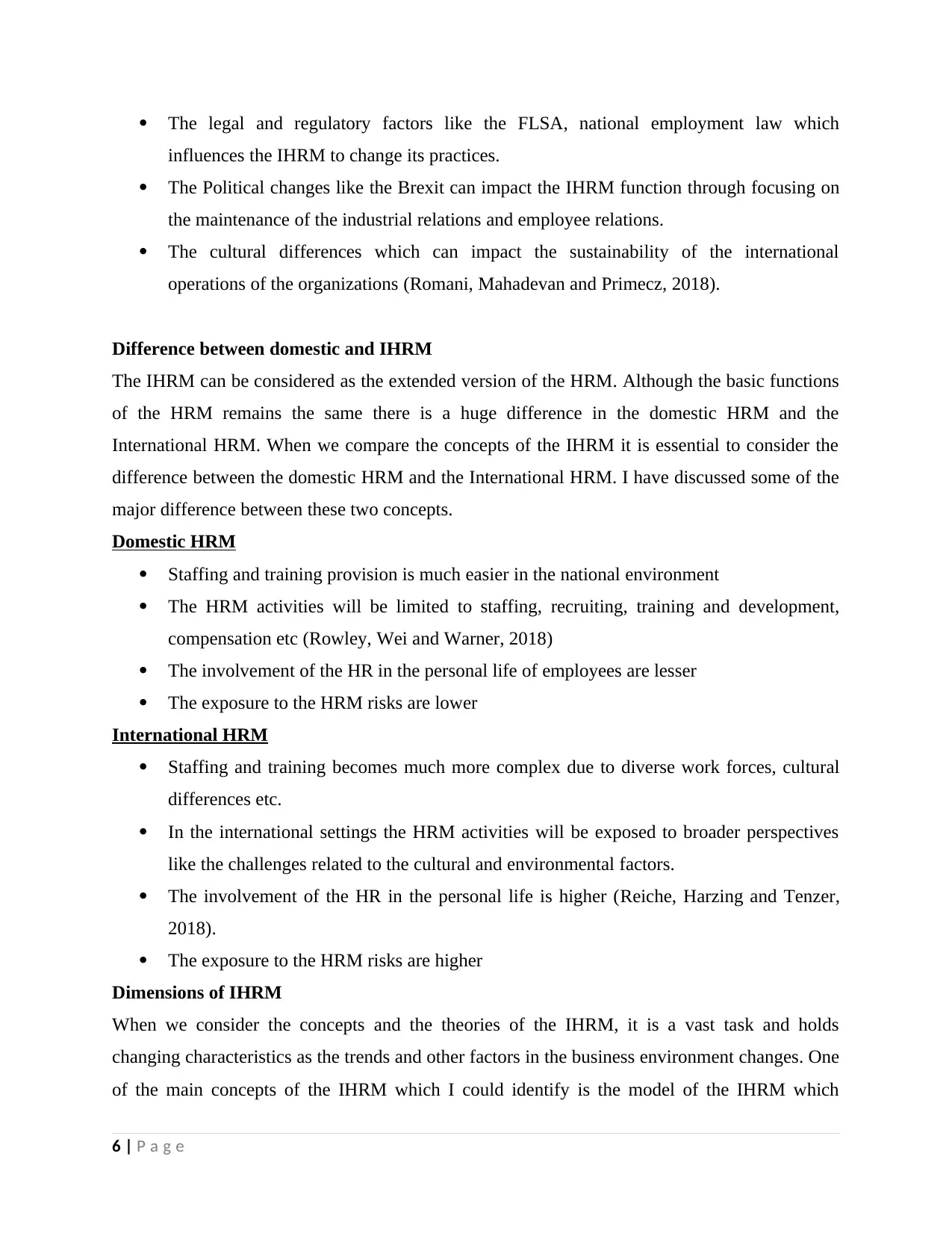
The legal and regulatory factors like the FLSA, national employment law which
influences the IHRM to change its practices.
The Political changes like the Brexit can impact the IHRM function through focusing on
the maintenance of the industrial relations and employee relations.
The cultural differences which can impact the sustainability of the international
operations of the organizations (Romani, Mahadevan and Primecz, 2018).
Difference between domestic and IHRM
The IHRM can be considered as the extended version of the HRM. Although the basic functions
of the HRM remains the same there is a huge difference in the domestic HRM and the
International HRM. When we compare the concepts of the IHRM it is essential to consider the
difference between the domestic HRM and the International HRM. I have discussed some of the
major difference between these two concepts.
Domestic HRM
Staffing and training provision is much easier in the national environment
The HRM activities will be limited to staffing, recruiting, training and development,
compensation etc (Rowley, Wei and Warner, 2018)
The involvement of the HR in the personal life of employees are lesser
The exposure to the HRM risks are lower
International HRM
Staffing and training becomes much more complex due to diverse work forces, cultural
differences etc.
In the international settings the HRM activities will be exposed to broader perspectives
like the challenges related to the cultural and environmental factors.
The involvement of the HR in the personal life is higher (Reiche, Harzing and Tenzer,
2018).
The exposure to the HRM risks are higher
Dimensions of IHRM
When we consider the concepts and the theories of the IHRM, it is a vast task and holds
changing characteristics as the trends and other factors in the business environment changes. One
of the main concepts of the IHRM which I could identify is the model of the IHRM which
6 | P a g e
influences the IHRM to change its practices.
The Political changes like the Brexit can impact the IHRM function through focusing on
the maintenance of the industrial relations and employee relations.
The cultural differences which can impact the sustainability of the international
operations of the organizations (Romani, Mahadevan and Primecz, 2018).
Difference between domestic and IHRM
The IHRM can be considered as the extended version of the HRM. Although the basic functions
of the HRM remains the same there is a huge difference in the domestic HRM and the
International HRM. When we compare the concepts of the IHRM it is essential to consider the
difference between the domestic HRM and the International HRM. I have discussed some of the
major difference between these two concepts.
Domestic HRM
Staffing and training provision is much easier in the national environment
The HRM activities will be limited to staffing, recruiting, training and development,
compensation etc (Rowley, Wei and Warner, 2018)
The involvement of the HR in the personal life of employees are lesser
The exposure to the HRM risks are lower
International HRM
Staffing and training becomes much more complex due to diverse work forces, cultural
differences etc.
In the international settings the HRM activities will be exposed to broader perspectives
like the challenges related to the cultural and environmental factors.
The involvement of the HR in the personal life is higher (Reiche, Harzing and Tenzer,
2018).
The exposure to the HRM risks are higher
Dimensions of IHRM
When we consider the concepts and the theories of the IHRM, it is a vast task and holds
changing characteristics as the trends and other factors in the business environment changes. One
of the main concepts of the IHRM which I could identify is the model of the IHRM which
6 | P a g e
⊘ This is a preview!⊘
Do you want full access?
Subscribe today to unlock all pages.

Trusted by 1+ million students worldwide
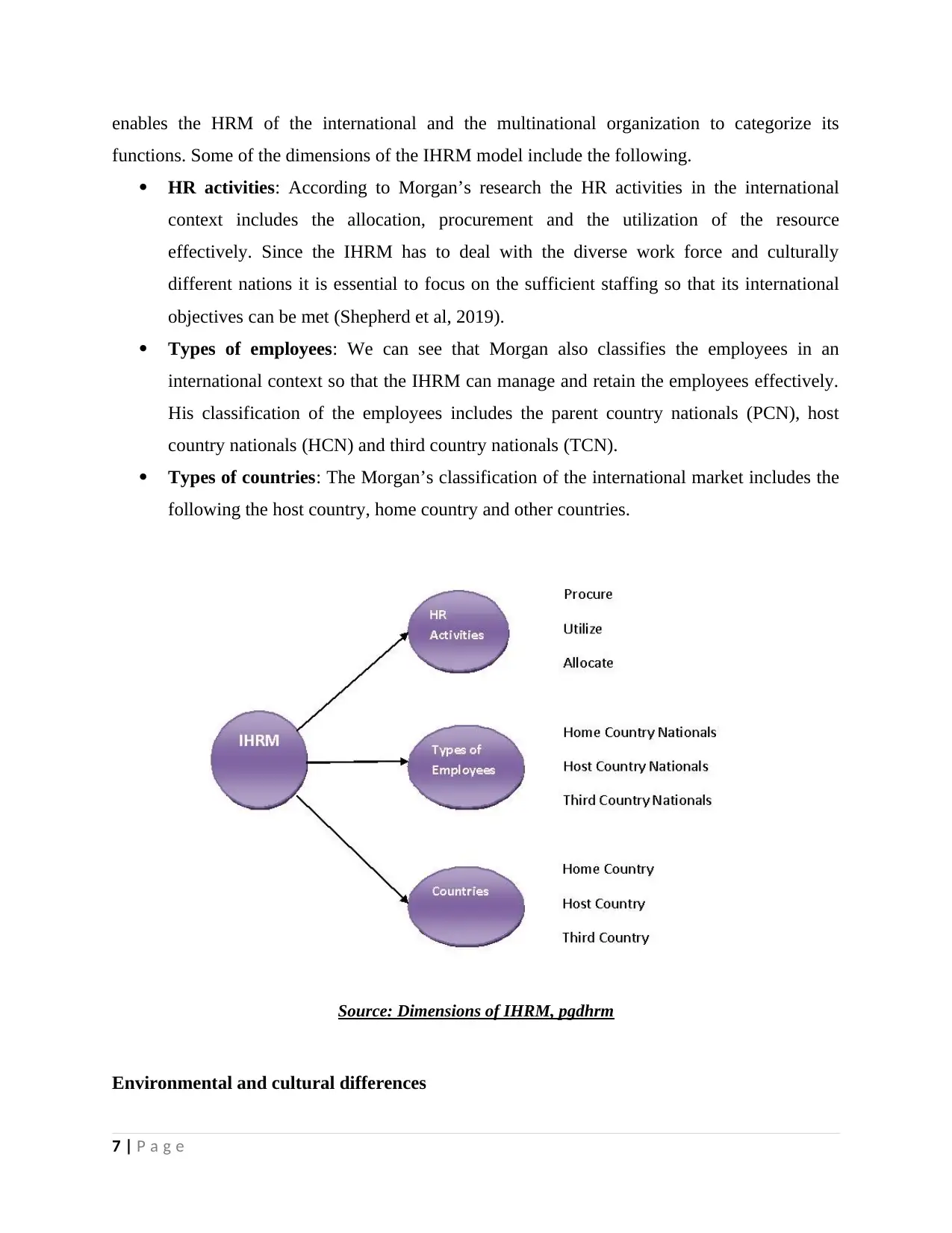
enables the HRM of the international and the multinational organization to categorize its
functions. Some of the dimensions of the IHRM model include the following.
HR activities: According to Morgan’s research the HR activities in the international
context includes the allocation, procurement and the utilization of the resource
effectively. Since the IHRM has to deal with the diverse work force and culturally
different nations it is essential to focus on the sufficient staffing so that its international
objectives can be met (Shepherd et al, 2019).
Types of employees: We can see that Morgan also classifies the employees in an
international context so that the IHRM can manage and retain the employees effectively.
His classification of the employees includes the parent country nationals (PCN), host
country nationals (HCN) and third country nationals (TCN).
Types of countries: The Morgan’s classification of the international market includes the
following the host country, home country and other countries.
Source: Dimensions of IHRM, pgdhrm
Environmental and cultural differences
7 | P a g e
functions. Some of the dimensions of the IHRM model include the following.
HR activities: According to Morgan’s research the HR activities in the international
context includes the allocation, procurement and the utilization of the resource
effectively. Since the IHRM has to deal with the diverse work force and culturally
different nations it is essential to focus on the sufficient staffing so that its international
objectives can be met (Shepherd et al, 2019).
Types of employees: We can see that Morgan also classifies the employees in an
international context so that the IHRM can manage and retain the employees effectively.
His classification of the employees includes the parent country nationals (PCN), host
country nationals (HCN) and third country nationals (TCN).
Types of countries: The Morgan’s classification of the international market includes the
following the host country, home country and other countries.
Source: Dimensions of IHRM, pgdhrm
Environmental and cultural differences
7 | P a g e
Paraphrase This Document
Need a fresh take? Get an instant paraphrase of this document with our AI Paraphraser
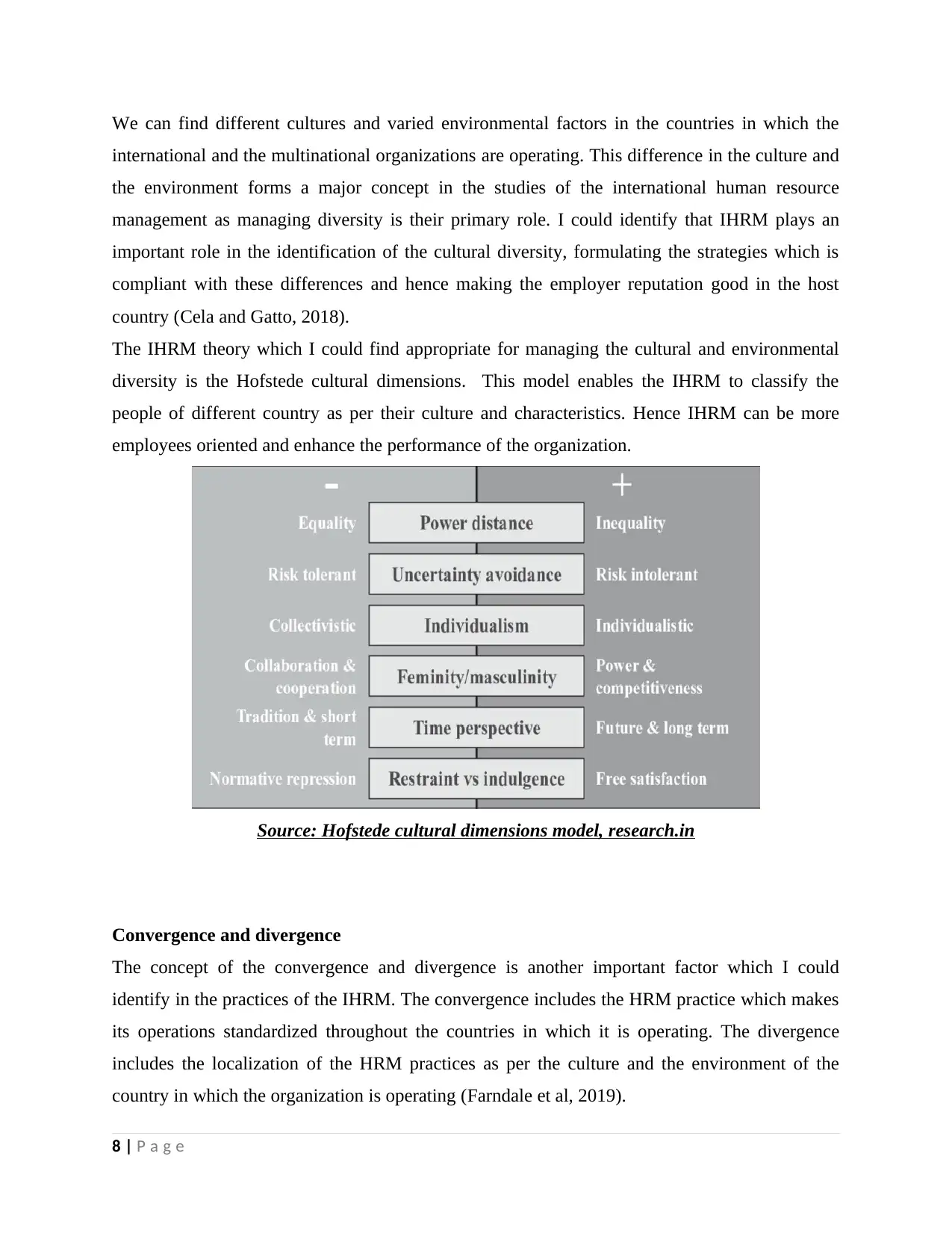
We can find different cultures and varied environmental factors in the countries in which the
international and the multinational organizations are operating. This difference in the culture and
the environment forms a major concept in the studies of the international human resource
management as managing diversity is their primary role. I could identify that IHRM plays an
important role in the identification of the cultural diversity, formulating the strategies which is
compliant with these differences and hence making the employer reputation good in the host
country (Cela and Gatto, 2018).
The IHRM theory which I could find appropriate for managing the cultural and environmental
diversity is the Hofstede cultural dimensions. This model enables the IHRM to classify the
people of different country as per their culture and characteristics. Hence IHRM can be more
employees oriented and enhance the performance of the organization.
Source: Hofstede cultural dimensions model, research.in
Convergence and divergence
The concept of the convergence and divergence is another important factor which I could
identify in the practices of the IHRM. The convergence includes the HRM practice which makes
its operations standardized throughout the countries in which it is operating. The divergence
includes the localization of the HRM practices as per the culture and the environment of the
country in which the organization is operating (Farndale et al, 2019).
8 | P a g e
international and the multinational organizations are operating. This difference in the culture and
the environment forms a major concept in the studies of the international human resource
management as managing diversity is their primary role. I could identify that IHRM plays an
important role in the identification of the cultural diversity, formulating the strategies which is
compliant with these differences and hence making the employer reputation good in the host
country (Cela and Gatto, 2018).
The IHRM theory which I could find appropriate for managing the cultural and environmental
diversity is the Hofstede cultural dimensions. This model enables the IHRM to classify the
people of different country as per their culture and characteristics. Hence IHRM can be more
employees oriented and enhance the performance of the organization.
Source: Hofstede cultural dimensions model, research.in
Convergence and divergence
The concept of the convergence and divergence is another important factor which I could
identify in the practices of the IHRM. The convergence includes the HRM practice which makes
its operations standardized throughout the countries in which it is operating. The divergence
includes the localization of the HRM practices as per the culture and the environment of the
country in which the organization is operating (Farndale et al, 2019).
8 | P a g e
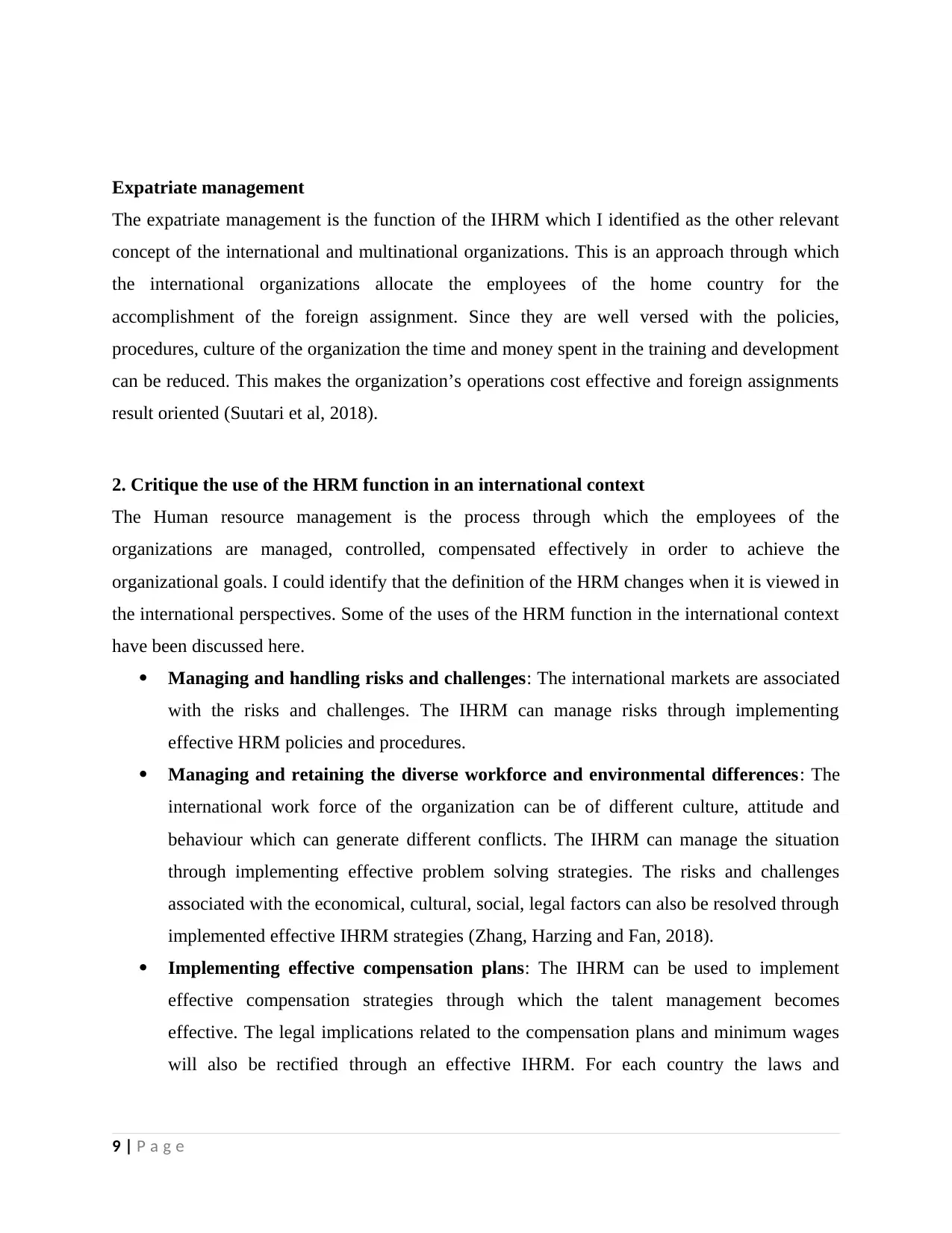
Expatriate management
The expatriate management is the function of the IHRM which I identified as the other relevant
concept of the international and multinational organizations. This is an approach through which
the international organizations allocate the employees of the home country for the
accomplishment of the foreign assignment. Since they are well versed with the policies,
procedures, culture of the organization the time and money spent in the training and development
can be reduced. This makes the organization’s operations cost effective and foreign assignments
result oriented (Suutari et al, 2018).
2. Critique the use of the HRM function in an international context
The Human resource management is the process through which the employees of the
organizations are managed, controlled, compensated effectively in order to achieve the
organizational goals. I could identify that the definition of the HRM changes when it is viewed in
the international perspectives. Some of the uses of the HRM function in the international context
have been discussed here.
Managing and handling risks and challenges: The international markets are associated
with the risks and challenges. The IHRM can manage risks through implementing
effective HRM policies and procedures.
Managing and retaining the diverse workforce and environmental differences: The
international work force of the organization can be of different culture, attitude and
behaviour which can generate different conflicts. The IHRM can manage the situation
through implementing effective problem solving strategies. The risks and challenges
associated with the economical, cultural, social, legal factors can also be resolved through
implemented effective IHRM strategies (Zhang, Harzing and Fan, 2018).
Implementing effective compensation plans: The IHRM can be used to implement
effective compensation strategies through which the talent management becomes
effective. The legal implications related to the compensation plans and minimum wages
will also be rectified through an effective IHRM. For each country the laws and
9 | P a g e
The expatriate management is the function of the IHRM which I identified as the other relevant
concept of the international and multinational organizations. This is an approach through which
the international organizations allocate the employees of the home country for the
accomplishment of the foreign assignment. Since they are well versed with the policies,
procedures, culture of the organization the time and money spent in the training and development
can be reduced. This makes the organization’s operations cost effective and foreign assignments
result oriented (Suutari et al, 2018).
2. Critique the use of the HRM function in an international context
The Human resource management is the process through which the employees of the
organizations are managed, controlled, compensated effectively in order to achieve the
organizational goals. I could identify that the definition of the HRM changes when it is viewed in
the international perspectives. Some of the uses of the HRM function in the international context
have been discussed here.
Managing and handling risks and challenges: The international markets are associated
with the risks and challenges. The IHRM can manage risks through implementing
effective HRM policies and procedures.
Managing and retaining the diverse workforce and environmental differences: The
international work force of the organization can be of different culture, attitude and
behaviour which can generate different conflicts. The IHRM can manage the situation
through implementing effective problem solving strategies. The risks and challenges
associated with the economical, cultural, social, legal factors can also be resolved through
implemented effective IHRM strategies (Zhang, Harzing and Fan, 2018).
Implementing effective compensation plans: The IHRM can be used to implement
effective compensation strategies through which the talent management becomes
effective. The legal implications related to the compensation plans and minimum wages
will also be rectified through an effective IHRM. For each country the laws and
9 | P a g e
⊘ This is a preview!⊘
Do you want full access?
Subscribe today to unlock all pages.

Trusted by 1+ million students worldwide
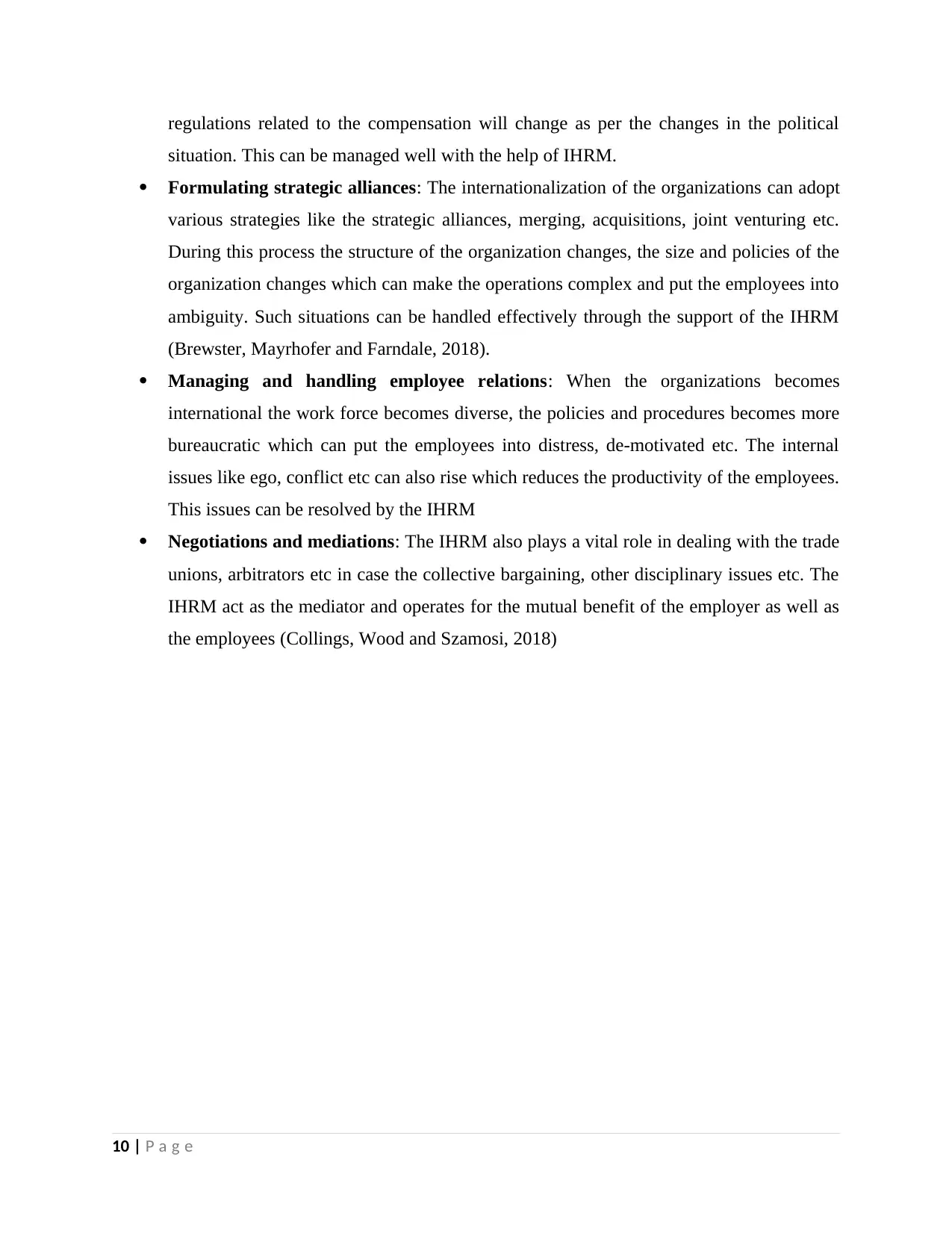
regulations related to the compensation will change as per the changes in the political
situation. This can be managed well with the help of IHRM.
Formulating strategic alliances: The internationalization of the organizations can adopt
various strategies like the strategic alliances, merging, acquisitions, joint venturing etc.
During this process the structure of the organization changes, the size and policies of the
organization changes which can make the operations complex and put the employees into
ambiguity. Such situations can be handled effectively through the support of the IHRM
(Brewster, Mayrhofer and Farndale, 2018).
Managing and handling employee relations: When the organizations becomes
international the work force becomes diverse, the policies and procedures becomes more
bureaucratic which can put the employees into distress, de-motivated etc. The internal
issues like ego, conflict etc can also rise which reduces the productivity of the employees.
This issues can be resolved by the IHRM
Negotiations and mediations: The IHRM also plays a vital role in dealing with the trade
unions, arbitrators etc in case the collective bargaining, other disciplinary issues etc. The
IHRM act as the mediator and operates for the mutual benefit of the employer as well as
the employees (Collings, Wood and Szamosi, 2018)
10 | P a g e
situation. This can be managed well with the help of IHRM.
Formulating strategic alliances: The internationalization of the organizations can adopt
various strategies like the strategic alliances, merging, acquisitions, joint venturing etc.
During this process the structure of the organization changes, the size and policies of the
organization changes which can make the operations complex and put the employees into
ambiguity. Such situations can be handled effectively through the support of the IHRM
(Brewster, Mayrhofer and Farndale, 2018).
Managing and handling employee relations: When the organizations becomes
international the work force becomes diverse, the policies and procedures becomes more
bureaucratic which can put the employees into distress, de-motivated etc. The internal
issues like ego, conflict etc can also rise which reduces the productivity of the employees.
This issues can be resolved by the IHRM
Negotiations and mediations: The IHRM also plays a vital role in dealing with the trade
unions, arbitrators etc in case the collective bargaining, other disciplinary issues etc. The
IHRM act as the mediator and operates for the mutual benefit of the employer as well as
the employees (Collings, Wood and Szamosi, 2018)
10 | P a g e
Paraphrase This Document
Need a fresh take? Get an instant paraphrase of this document with our AI Paraphraser
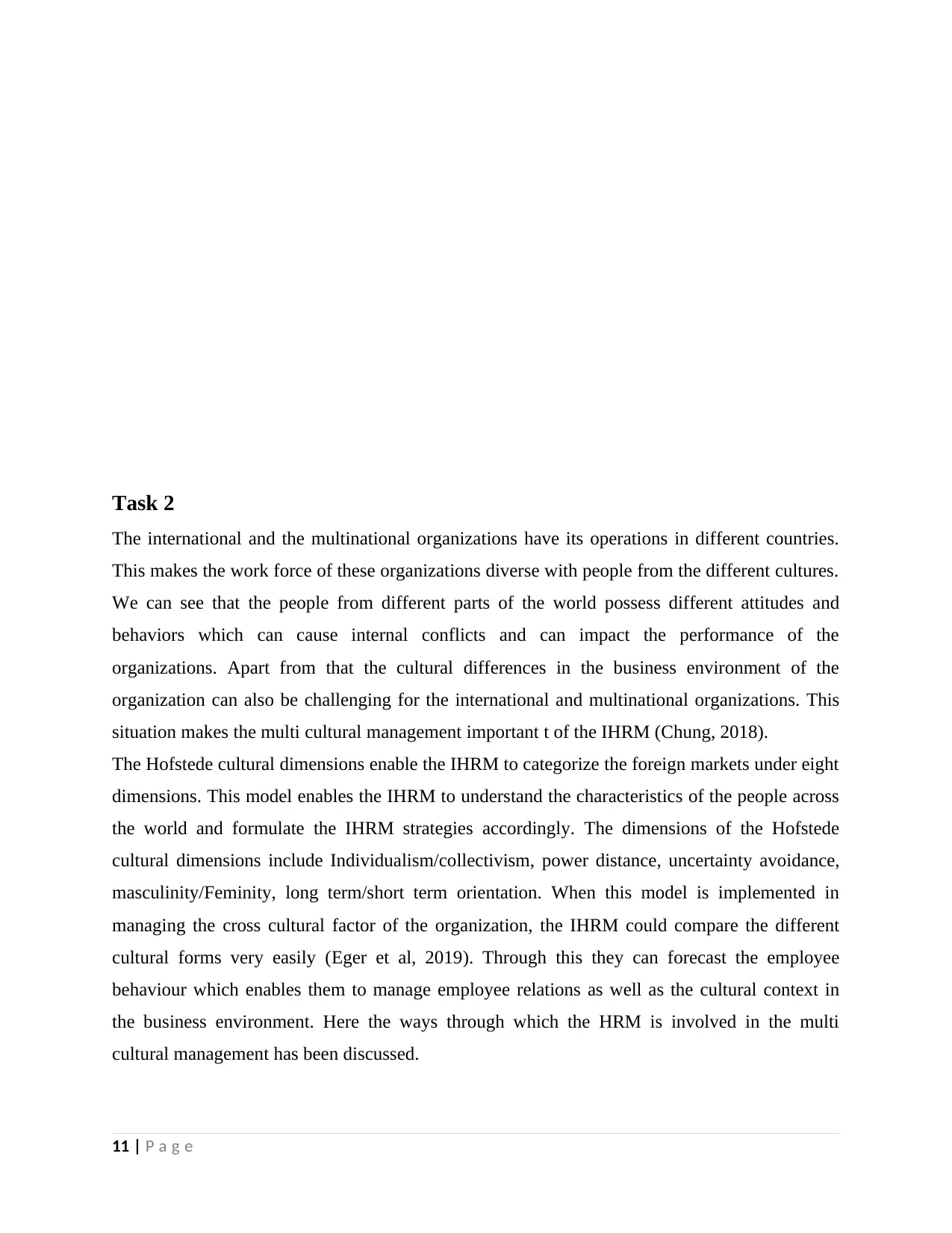
Task 2
The international and the multinational organizations have its operations in different countries.
This makes the work force of these organizations diverse with people from the different cultures.
We can see that the people from different parts of the world possess different attitudes and
behaviors which can cause internal conflicts and can impact the performance of the
organizations. Apart from that the cultural differences in the business environment of the
organization can also be challenging for the international and multinational organizations. This
situation makes the multi cultural management important t of the IHRM (Chung, 2018).
The Hofstede cultural dimensions enable the IHRM to categorize the foreign markets under eight
dimensions. This model enables the IHRM to understand the characteristics of the people across
the world and formulate the IHRM strategies accordingly. The dimensions of the Hofstede
cultural dimensions include Individualism/collectivism, power distance, uncertainty avoidance,
masculinity/Feminity, long term/short term orientation. When this model is implemented in
managing the cross cultural factor of the organization, the IHRM could compare the different
cultural forms very easily (Eger et al, 2019). Through this they can forecast the employee
behaviour which enables them to manage employee relations as well as the cultural context in
the business environment. Here the ways through which the HRM is involved in the multi
cultural management has been discussed.
11 | P a g e
The international and the multinational organizations have its operations in different countries.
This makes the work force of these organizations diverse with people from the different cultures.
We can see that the people from different parts of the world possess different attitudes and
behaviors which can cause internal conflicts and can impact the performance of the
organizations. Apart from that the cultural differences in the business environment of the
organization can also be challenging for the international and multinational organizations. This
situation makes the multi cultural management important t of the IHRM (Chung, 2018).
The Hofstede cultural dimensions enable the IHRM to categorize the foreign markets under eight
dimensions. This model enables the IHRM to understand the characteristics of the people across
the world and formulate the IHRM strategies accordingly. The dimensions of the Hofstede
cultural dimensions include Individualism/collectivism, power distance, uncertainty avoidance,
masculinity/Feminity, long term/short term orientation. When this model is implemented in
managing the cross cultural factor of the organization, the IHRM could compare the different
cultural forms very easily (Eger et al, 2019). Through this they can forecast the employee
behaviour which enables them to manage employee relations as well as the cultural context in
the business environment. Here the ways through which the HRM is involved in the multi
cultural management has been discussed.
11 | P a g e
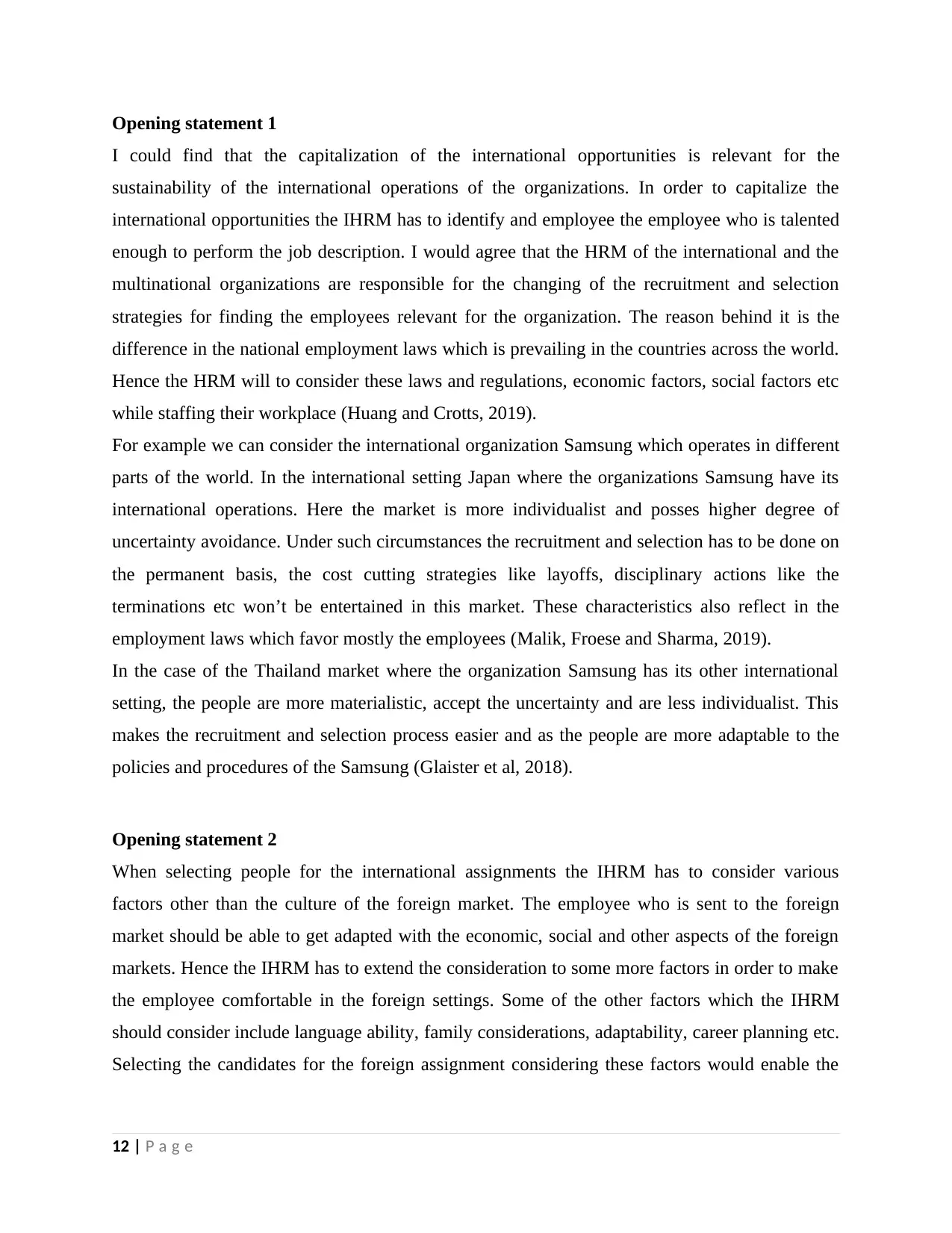
Opening statement 1
I could find that the capitalization of the international opportunities is relevant for the
sustainability of the international operations of the organizations. In order to capitalize the
international opportunities the IHRM has to identify and employee the employee who is talented
enough to perform the job description. I would agree that the HRM of the international and the
multinational organizations are responsible for the changing of the recruitment and selection
strategies for finding the employees relevant for the organization. The reason behind it is the
difference in the national employment laws which is prevailing in the countries across the world.
Hence the HRM will to consider these laws and regulations, economic factors, social factors etc
while staffing their workplace (Huang and Crotts, 2019).
For example we can consider the international organization Samsung which operates in different
parts of the world. In the international setting Japan where the organizations Samsung have its
international operations. Here the market is more individualist and posses higher degree of
uncertainty avoidance. Under such circumstances the recruitment and selection has to be done on
the permanent basis, the cost cutting strategies like layoffs, disciplinary actions like the
terminations etc won’t be entertained in this market. These characteristics also reflect in the
employment laws which favor mostly the employees (Malik, Froese and Sharma, 2019).
In the case of the Thailand market where the organization Samsung has its other international
setting, the people are more materialistic, accept the uncertainty and are less individualist. This
makes the recruitment and selection process easier and as the people are more adaptable to the
policies and procedures of the Samsung (Glaister et al, 2018).
Opening statement 2
When selecting people for the international assignments the IHRM has to consider various
factors other than the culture of the foreign market. The employee who is sent to the foreign
market should be able to get adapted with the economic, social and other aspects of the foreign
markets. Hence the IHRM has to extend the consideration to some more factors in order to make
the employee comfortable in the foreign settings. Some of the other factors which the IHRM
should consider include language ability, family considerations, adaptability, career planning etc.
Selecting the candidates for the foreign assignment considering these factors would enable the
12 | P a g e
I could find that the capitalization of the international opportunities is relevant for the
sustainability of the international operations of the organizations. In order to capitalize the
international opportunities the IHRM has to identify and employee the employee who is talented
enough to perform the job description. I would agree that the HRM of the international and the
multinational organizations are responsible for the changing of the recruitment and selection
strategies for finding the employees relevant for the organization. The reason behind it is the
difference in the national employment laws which is prevailing in the countries across the world.
Hence the HRM will to consider these laws and regulations, economic factors, social factors etc
while staffing their workplace (Huang and Crotts, 2019).
For example we can consider the international organization Samsung which operates in different
parts of the world. In the international setting Japan where the organizations Samsung have its
international operations. Here the market is more individualist and posses higher degree of
uncertainty avoidance. Under such circumstances the recruitment and selection has to be done on
the permanent basis, the cost cutting strategies like layoffs, disciplinary actions like the
terminations etc won’t be entertained in this market. These characteristics also reflect in the
employment laws which favor mostly the employees (Malik, Froese and Sharma, 2019).
In the case of the Thailand market where the organization Samsung has its other international
setting, the people are more materialistic, accept the uncertainty and are less individualist. This
makes the recruitment and selection process easier and as the people are more adaptable to the
policies and procedures of the Samsung (Glaister et al, 2018).
Opening statement 2
When selecting people for the international assignments the IHRM has to consider various
factors other than the culture of the foreign market. The employee who is sent to the foreign
market should be able to get adapted with the economic, social and other aspects of the foreign
markets. Hence the IHRM has to extend the consideration to some more factors in order to make
the employee comfortable in the foreign settings. Some of the other factors which the IHRM
should consider include language ability, family considerations, adaptability, career planning etc.
Selecting the candidates for the foreign assignment considering these factors would enable the
12 | P a g e
⊘ This is a preview!⊘
Do you want full access?
Subscribe today to unlock all pages.

Trusted by 1+ million students worldwide
1 out of 19
Related Documents
Your All-in-One AI-Powered Toolkit for Academic Success.
+13062052269
info@desklib.com
Available 24*7 on WhatsApp / Email
![[object Object]](/_next/static/media/star-bottom.7253800d.svg)
Unlock your academic potential
Copyright © 2020–2025 A2Z Services. All Rights Reserved. Developed and managed by ZUCOL.




